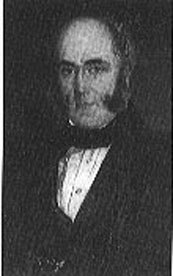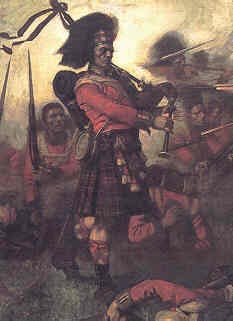|
|
|
THE 1ST BATTALION 79TH
QUEEN'S OWN CAMERON HIGHLANDERS
|
History
of the Regiment (1793 - 1918)
|
| The 1st Battalion 79th Cameron Highlanders was raised by Alan Cameron of Errachtin 1793. The Regiment was known as the 79th Regiment of Foot(Cameronian Volunteers). In 1806, the official name of record was changed and the regiment bacame the 79th Cameron Highlanders. |
 |
|
Sir Alan Cameron of
Erracht
|
| The reigment won 15 battle honours and earned special renown in the Napoleonic Wars, especially during the Penisular Campaign and the Battle of Waterloo in 1815. |
| The 79th Cameron Highlanders was one of four regiments of highlanders requested by the Duke of Wellington for the Battle of Waterloo. On 16th of June, 1815 the regiment was at Quatre Bras, where the French infantry and cavalry kept them under constant attack. The Cameron lost half their fighting strength, dead and wounded, in this battle. Wellington's forces left Quatre Bras on the 17th after a miserable night in the fields and proceeded to the area known as Waterloo. They arrived wet, hungry and tired after their long march in time to face the French again. At a very critical moment during this battle when the regiment formed a square to repel the French cavalry an astonishing event took place. Piper Kenneth MacKay stepped outside the square and played the ancient rallying tune (pibroch) "Cogadh no Sith" (War or Peace). By nightfall the Great Army of Napoleon had been destroyed. |
 |
|
Piper Kenneth MacKay
at Waterloo, June 1815
|
| The regiment spent many years abroad after Waterloo, with several tours of duty in Canada and one in Gibraltar. This is where Pipe-Major John MacDonald composed the famaous pipe tune "The 79th's Farewell to Gibraltar". Also, the regiment spent many of these peaceful years at home in Scotland. Then in 1854, the regiment was sent to The Crimea to join Sir Colin Campbell's Highland Brigade. The regiment won two more battle honours at Alma and Sevastapol. Barely a year (1856) at home after the Crimean War, the regiment was given orders to sail to India to help quell the famous Indian Mutiny. They were led by their old commander, Sir Colin Campbell, and took part in the recapture of Lucknow and the residency in 1858. The rest of the time was spent in the final stages of cleanup of the mutiny with the additional capture of several more of rebel strongholds and the recapture of Baeilly. The 79th Highlanders stayed in India for the next 12 years before returning to Scotland. |
| For the next two years the regiment was station on the Isle of Wight, where they performed the ceremonial duties for Her Majesty Queen Victoria, of the United Kingdom of Great Britain, the Empire, and Empress of India when she was at Osborne. From her affection for this famous regiment, in 1873 she gave them their new title"The 79th Queen's Own Cameron Higlanders". |
| In 1879 the regiment sailed for Gibraltar, where they were stationed during the reforms that were taking place in 1881. The 79th was the only regiment in the entire army to escape the dreaded amalgamation, since they only had a single battalion. As of 1881 the 79th was the only highland regiment to have a single battalion and the 79 was officially dropped. |
| In 1882 the Cameron's sailed for Egypt from their post at Gibraltar, to take part in the succesful campaign at Tel-el-Kebir under General Wolsely's command. |
|
|
|
Tel-el-Kebir
|
| The regiment remained in Eygpt until 1886, where they were to operate on the Sudanese boarder against the Dervishes. Then they returned to Egypt after some time at home, as well as being stationed a Malta and Gibraltar. While they were back in Egypt, the regiment was order to joined Kitchener's forces in the retaking of the Sudan in January of 1898. |
| In 1897, only 104 years after the raising of the regiment by Sir Alan Cameron of Erracht, a second battalion was raised to help bring the regiment up to full strength by 1899. |
| New colours were presented by Queen Victoria in October of 1898 at Balmoral Castle to the Queen's Own Cameron Highlanders. |
| The Queen's Own Cameron Highlanders were still station in Cairo in 1899, when the South African Boar War commenced in 1900, and due to the fact that reinforcements were desperately needed in South Africa, that 79th were given orders to sail from the Suez to South Africa, where they became part of the 21st Infantry Brigade under the command of Major General Ian Hamilton's column and proceeded to march from Bloemfontein to Johannesburg and to Pretoria. |
| With the fall of Pretoria, the Cameron joined in pursuing the Boars forces, which had escaped from Pretoria, and on the June 11th and 12th, 1900 the 1st Cameron's were engaged in a victorious attack on the Boer's position at the Battle of Diamond Hill, which is just outside of Pretoria. |
| Then in July of 1900, the 1st Cameron's became part of General Sir Archibald Hunter's Force that also included the Highland Brigade, which took part in the operations within the Orange River Colony. The 1st Cameron's engaged in an arduous pursuit which led them to surround and capture General Prinsloo's army at Brandwater Basin in the Wittebergen Mts, and also had a fierce conflict with the capture of Spitzkopf. This was the second major surrender of the Boar forces during the conflict. |
| At the Battle of Nooitgedacht in 1900, Sergeant J.D. Farmer is awarded the Victoria Cross for valor. During the later stages of the Boer War, the 1st Cameron's operated in and around Kroonstad in the Orange River Colony. During this time the Battalion made excursions to Ladybrand and also to the northwest of the colony. Then in 1901 the 1st Cameron's went north to the Transvaal, to take part in build and manning the series of strategic block houses, which aided General Kitchener in dividing up the country and clearing each section. Within those two and half years the 1st Cameron's had marched approximately 3000miles(4827.9km) while on active duty in the region. |
| During the whole campaign the Cameron's lost only 24 officers and other ranks while engaging the enemy. Also during this time the 1st Battalion Queen's Own Cameron Highlanders had received their reinforcements from the Volunteer Service Company of the 1st Cameron's. Along with the eight drafts form the 2nd Bat., who was stationed in Gibraltar, and drafts from the 3rd Battalion, which had been raised from a militia unit in 1900. |
| The 1st Battalion Queen's Own Cameron Highlanders added another Battle Honor to their record, for services in South Africa 1900-1902. |
| The Battalion returned to Fort George, Inverness, after their two year tour of duty in South Africa. Then in 1904 the 1st Battalion provided the Royal Guard at Balmoral Castle. |
| The Cameron's left for Ireland in 1904. In the three years that the 1st Cameron's were in Ireland, were primarily ceremonial duties in Dublin for King Edward VII. The in 1907 the Cameron's were sent to Belfast to help reinforce the garrison during a serious rioting in Ulster. |
| After being stationed in Belfast, the Cameron's went on to Tidworth and then to Aldershot in 1909. In 1910, they paraded King Edward VII funeral in London. In 1911, were a detachment of the Cameron Highland of Canada took part in the coronation ceremonies for King George V. |
| The 1st Battalion was stationed in 1913 at Edinburgh Castle until 1914 when war broke out in Europe. The 1st Battalion Queen's Own Cameron Highlanders marched out of Edinburgh Castle to head to France. |
| The Cameron Highlanders are the only clan-raised unit with their own tartan, which is not based on the goverment tartan. The tartan worn by the regiment is the Cameron of Erracht. Alan Cameron's mother is believed to have devised this particular tartan. |
|
HOME
|
NEXT |